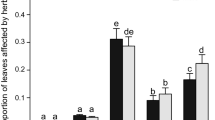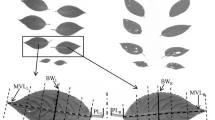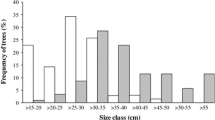Abstract
To examine gender-related developmental instability and herbivory of a plant across a steep climatic gradient, we studiedPistacia atlantica DESF., a dioecious tree of the Irano-Turanian zone in the Middle East. Leaves were sampled from five populations along a climatic gradient in Israel from mesic Mediterranean to xeric (and geographically peripheral) sites. Leaves of the xeric populations were ca. 25% smaller in size (length) than leaves of other populations. Leaf developmental instability (an indicator of stress) was examined using the measurement of leaf asymmetry (LA), estimated by the deviation from the origin of paired lateral leaflets and by the presence vs. absence of the terminal leaflet. LA was not correlated with the climatic (site) gradient and had the highest, though not significantly, levels in the intermediate ecotonal zone between the Mediterranean and the arid ecosystems. Male trees were 13% higher in LA than females. Density of two specialist gall-forming aphids varied with site but was not affected by plant gender. Gender-related developmental instability is discussed in relation to resource allocation in early spring. Because the study was limited to five populations further research is clearly needed.
Similar content being viewed by others
References
Ågren J., Danell K., Elmqvist T., Ericson L. & Hjältén J. (1999): Sexual dimorphism and biotic interactions. In: Geber M.A., Dawson T.F. & Delph L.F. (eds.),Gender and sexual dimorphism in flowering plants, Springer, pp. 217–246.
Auslander M., Nevo E. & Inbar M. (1998): The effects of slope orientation on plant growth, developmental instability and susceptibility to herbivores.J. Arid Environm. 55: 405–416.
Boecklen W.J. & Hoffman M. (1993): Sex-biased herbivory inEphedra trifurca: the importance of sex-by-environment interactions.Oecologia 96: 49–55.
Boecklen W.J., Price P.W. & Mopper S. (1990): Sex and drugs and herbivores: sex-biased herbivory in arroyo willow (Salix lasiolepis).Ecology 71: 581–588.
Bogen R., Wool D. & Shmida A. (1997): Host tree sex ratio and herbivores gall abundance:Pistacia trees and galling aphids.Ecol. Environm. 4: 3–10. (In Hebrew)
Burstein M. & Wool D. (1993) Gall aphids do not select optimal galling sites (Smynthurodes betae: Pemphigidae).Ecol. Entomol. 18: 155–164.
Castro-Díez P., Villar-Salvador P., Pérez-rontomé C., Maestro-Martínez M. & Montserrat-Martí G. (1998): Leaf morphology, leaf chemical composition and stem xylem characteristics in twoPistacia (Anacardiaceae) species along a climatic gradient.Flora 193: 195–202.
Clarke G.M. (1995): The genetic basis of developmental stability. II. Asymmetry of extreme phenotypes revisited.Amer. Naturalist 146: 708–725.
Correia O. & Diaz Barradas M.C. (2000): Ecophysiological differences between male and female plants ofPistacia lentiscus L.Pl. Ecol. 149: 131–142.
Danin A. (1999): Sandstone outcrops - a major refugium of Mediterranean flora in the xeric part of Jordan.Israel J. Pl. Sci. 47: 179–187.
Dawson T.E. & Geber M.A. (1999): Sexual dimorphism in physiology and morphology. In: Geber M.A., Dawson T.E. & Delph L.F. (eds.),Gender and sexual dimorphism in flowering plants, Springer, pp. 123–148.
Delph L.F. (1999): Sexual dimorphism in life history. In: Geber M.A., Dawson T.E. & Delph L.F. (eds.),Gender and sexual dimorphism in flowering plants, Springer, pp. 149–173.
Emlen J.M., Freeman D.C. & Graham J.H. (1993): Nonlinear growth dynamics and the origin of fluctuating asymmetry.Genetica 89: 77–96.
Freeman D.C., Graham J.H. & Emlen J.M. (1993): Development instability in plants: symmetries, stress and epigenesis.Genetica 89: 97–119.
Gibson A.C. (1998): Photosynthetic organs of desert plants.Bioscience 48: 911–920.
Gichua M.K., Avni Y. & Gutterman Y. (2002): The effect of habitat and erosion on the distribution and development ofPistacia atlantica trees in the central Negev highlands of Israel.Israel J. Pl. Sci. 50: 281–286.
Graham J.H., Freeman D.C. & Emlen J.M. (1993): Antisymmetry, directional asymmetry, and dynamic morphogenesis.Genetica 89: 121–137.
Hjältén J., Aström M., Aberg E. & Danell K. (1993): Biased sex ratios in Spanish populations ofPistacia lentiscus (Anacardiaceae): the possible role of herbivory.Anales Jard. Bot. Madrid 51: 49–53.
Inbar M., Doostdar H. & Mayer R.T. (2001): Suitability of stressed and vigorous plants to various insect herbivores.Oikos 94: 228–235
Inbar M., Wink M. & Wool D. (2004): The evolution of host plant manipulation by insects: molecular and ecological evidence from gall-forming aphidson Pistacia.Molec. Phylogenet. Evol. 32: 504–511.
Inbar M. & Wool D. (1995): Phloem-feeding specialists sharing a host tree: resource partitioning minimizes interference competition among galling aphid species.Oikos 73: 109–119.
Jonasson S., Medrano H. & Flexas J. (1997): Variation in leaf longevity ofPistacia lentiscus and its relationship to sex and drought stress inferred from leaf δ13C.Funct. Ecol. 11: 282–289.
Kark S. (2001): Shifts in bilateral asymmetry within a distribution range: the case of the chukar partridge.Evolution 55: 2088–2096.
Kark S., Safriel U., Tabarroni C. & Randi E. (2001): Relationship between heterozygosity and asymmetry: a test across the distribution range.Heredity 86: 119–127.
Lappalainen J.H., Martel J., Lempa K., Wilsey B. & Ossipov V. (2000): Effects of resource availability on carbon allocation and developmental instability in cloned birch seedlings.Int. J. Pl. Sci. 161: 119–125.
Leary R.F. & Allendorf F.W. (1989): Fluctuating asymmetry as an indicator of stress: implications for conservation biology.Trends Ecol. Evol. 4: 214–217.
Lempa K., Martel J., Koricheva J., Haukioja E., Ossipov V., Ossipova S. & Pihlaja K. (2000): Covariation of fluctuating asymmetry, herbivory and chemistry during birch leaf expansion.Oecologia 122: 354–360.
Lessells C.M. & Boag P.T. (1987): Unrepeatable repeatabilities: a common mistake.Auk 104: 116–121.
Møller A.P. (1995): Leaf-mining insects and fluctuating asymmetry in elmUlmus glabra leaves.J. Anim. Ecol. 64: 697–707.
Møller A.P. (1998): Developmental instability of plants and radiation from Chernobyl.Oikos 81: 444–448.
Møller A.P. & Swaddle J.P. (1997):Asymmetry, developmental stability, and evolution. Oxford University Press Inc., New York.
Price P. W. (1991): The plant vigor hypothesis and herbivore attack.Oikos 62: 244–251.
Rottenberg A. (1998): Sex ratio and gender stability in the dioecious plant of Israel.Bot. J. Linn. Soc. 128: 137–148.
Roy B.A. & Stanton M.L. (1999): Asymmetry of wild mustard,Sinapis arvensis (Brassicaceae), in response to severe physiological stresses.J. Evol. Biol. 12: 440–449.
Wertheim G. & Linder J. (1961): The early development of the cauliflower gall.Bull. Res. Council Israel 10B 59: 1164–1176.
Wiggins D.A. (1997): Fluctuating asymmetry inColophospermum mopane leaves and oviposition preference in an African silk mothImbrasia belina.Oikos 79: 484–488.
Wool D. & Bogen R. (1999): Ecology of the gall-forming aphidSlavum wertheimae, onPistacia atlantica: population dynamics and differential herbivory.Israel J. Zool. 45: 247–260.
Wool D. & Burstein M. (1991): A galling aphid with extra life cycle complexity: population ecology and evolutionary considerations.Res. Populat. Ecol. 33: 307–322.
Zohary M. (1952): A monographical study of the genusPistacia.Palestine J. Bot. 5: 187–228.
Author information
Authors and Affiliations
Corresponding author
Rights and permissions
About this article
Cite this article
Inbar, M., Kark, S. Gender-Related developmental instability and herbivory ofPistacia atlantica across a steep environmental gradient. Folia Geobot 42, 401–410 (2007). https://doi.org/10.1007/BF02861702
Received:
Accepted:
Issue Date:
DOI: https://doi.org/10.1007/BF02861702




